
Aleksi
Presented below is an all-in-one hub for all your B2B sales statistics needs.
More and more companies don't base their sales and marketing on data, but rather guess and rely on estimates.
This article covers a wide array of information about topics and regions related to the B2B space.
Sales Statistics by Subject Matter
B2B Sales Statistics
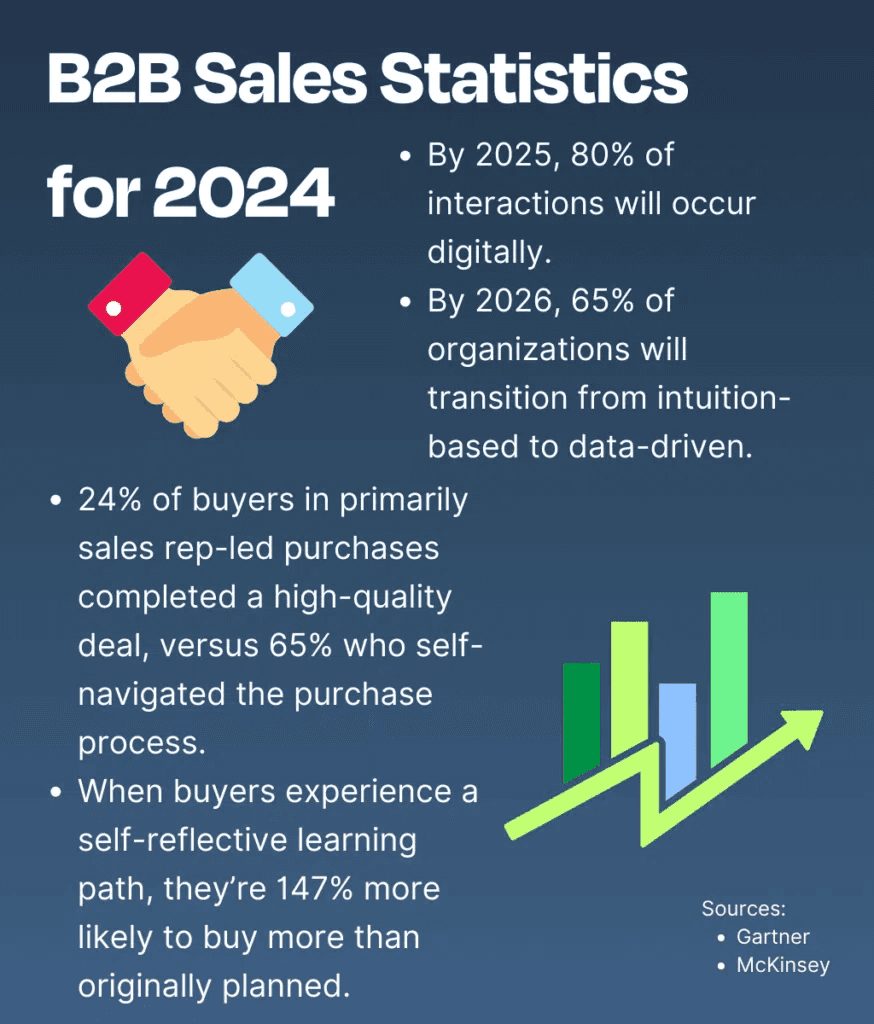
B2B sales is the process of selling products to businesses. The sales process in B2B sales is often more complex than in B2C sales. It involves multiple decision-makers and longer sales cycles. Here are some general statistics that you need to know about B2B sales.
By 2025, 80% of B2B sales interactions will occur via digital channels. (Gartner)
By 2026, 65% of B2B sales organizations will transition from intuition-based to data-driven. (Gartner)
Only 24% of B2B buyers in primarily sales rep-led purchases completed a high-quality deal, versus 65% of B2B buyers who self-navigated the purchase process. (Gartner)
When B2B buyers experience a self-reflective learning path, they are 147% more likely to buy more than originally planned. (Gartner)
71% of B2B buyers are willing to spend more than $50,000 in a single transaction using a remote or self-service model. (McKinsey)
B2B buyers use up to and sometimes more than 10 channels, including online and digital, as part of any purchase, double the number of channels 5 years ago. (McKinsey)
60% of companies increased hybrid sales teams, and 62 percent added to their digital sales teams in 2021. (McKinsey)
75% of B2B buyers prefer a rep-free sales experience. (Gartner)
B2B buyers are 1.8 times more likely to complete a deal when they engage with supplier-provided digital tools in partnership with a sales rep rather than independently. (Gartner)
99% of B2B purchases are driven by organizational changes. (Gartner)
Key Takeaways from B2B Buying Trends
B2B buying has rapidly shifted toward digital, data-driven, and self-guided experiences.
Most interactions now happen online, with buyers using twice as many channels as they did five years ago. Sales organizations are adapting too, increasingly investing in digital and hybrid teams, and moving away from intuition toward data-backed decisions.
Buyers overwhelmingly prefer rep-free or self-service paths, and those who follow a guided, reflective digital journey are far more likely to increase their purchase size. Yet sales reps still matter: deals are significantly more likely to close when digital tools are combined with human support.
Overall, B2B purchases are primarily triggered by organizational changes, and buyers are now comfortable spending even $50,000+ through remote or self-serve models.
Make sure your sales strategy aligns with these trends and that you're giving your sales team what they need to succeed.
Outbound Sales Statistics
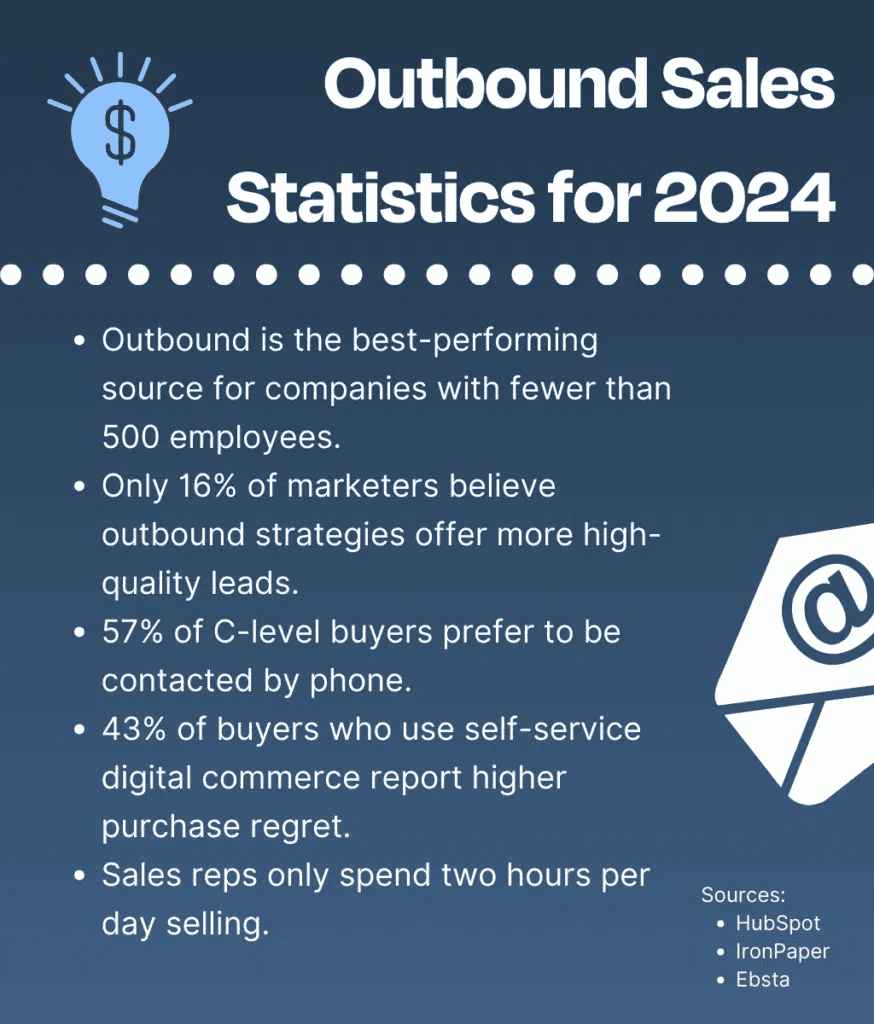
Outbound sales refer to salespeople proactively reaching out to prospects via cold outreach or referrals. Below are some current statistics that can help you in your outbound sales:
Outbound is the best-performing source for companies with fewer than 500 employees. (Ebsta)
Only 16% of marketers believe outbound strategies offer more high-quality leads. (Ironpaper)
52% of outbound marketers say their strategies are “ineffective.” (Ironpaper)
57% of C-level buyers prefer to be contacted by phone. (Crunchbase)
43% of buyers who use self-service digital commerce report higher purchase regret. (Gartner)
50% of CSOs believe that enablement will support marketing and customer success roles in the next three years. (Gartner)
35% of B2B decision makers state they’re willing to spend over $500,000 or more on a single interaction on remote or self-service channels. (McKinsey)
Sales reps only spend two hours per day selling. (HubSpot)
61% of organizations plan to increase their technology spending in 2024. (Gartner)
Key Takeaway: Outbound strategies are powerful and effective for small to medium-sized companies. However, a few sales and marketing professionals believe they’ll yield high-quality results. Lastly, companies are further investing in sales development and enablement technologies.
Inbound Sales Statistics
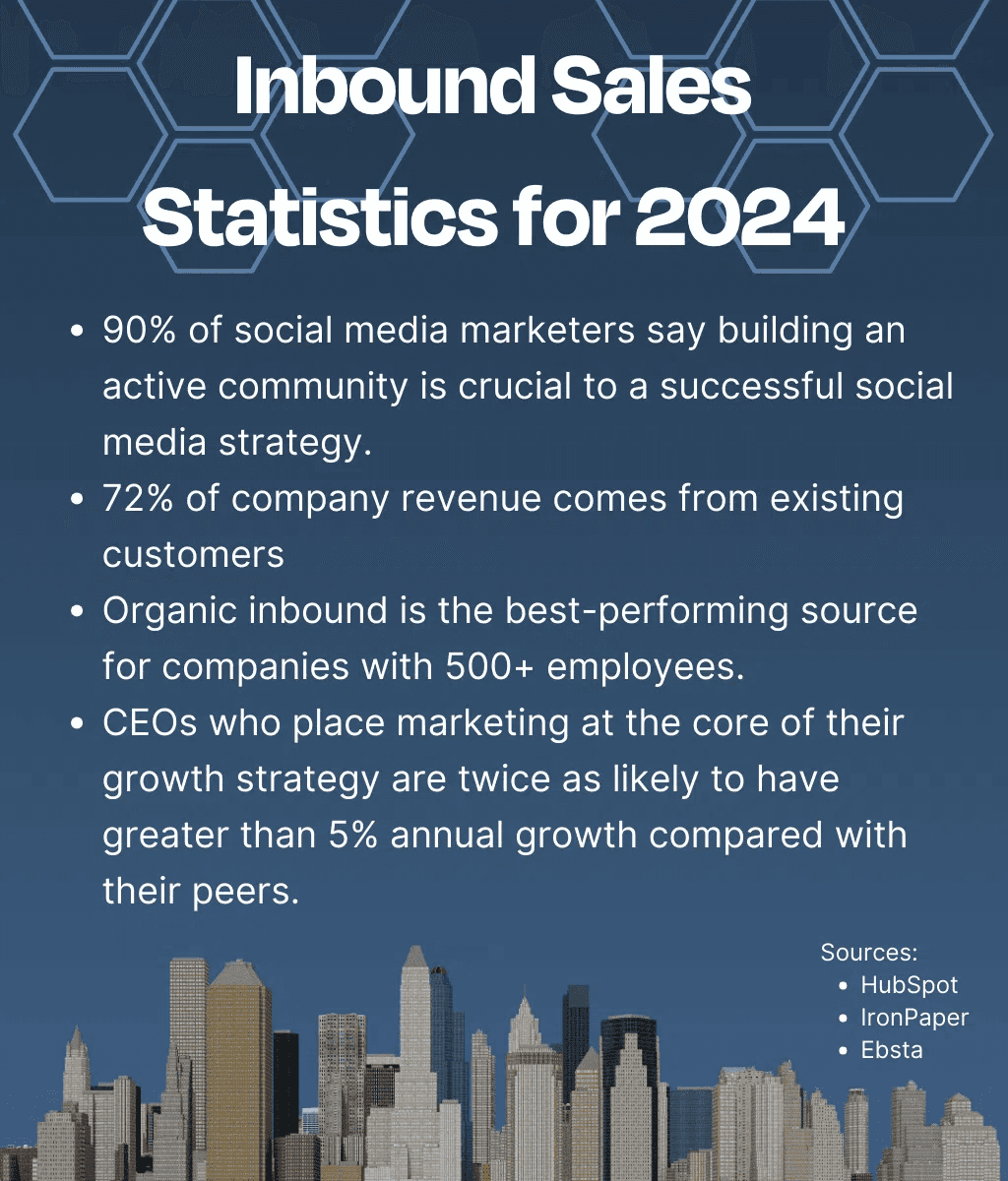
Inbound strategies have emerged as a cornerstone for generating high-quality leads. Check out how inbound strategies can benefit your organization:
59% of marketing professionals believe inbound marketing strategies lead to the most high-quality leads. (Ironpaper)
Organic inbound is the best-performing source for companies with 500+ employees. (Ebsta)
90% of social media marketers say building an active online community is crucial to a successful social media strategy. (HubSpot)
Over 41% of marketers measure the success of their content marketing strategy through sales. (HubSpot)
94% of marketers state that personalization boosts sales (HubSpot)
CEOs who place marketing at the core of their growth strategy are twice as likely to have greater than 5% annual growth compared with their peers. (McKinsey)
Sales reps spend about one hour per day on administrative tasks. (HubSpot)
There’s an average of five decision-makers involved in every sales process today. (HubSpot)
28% of sales pros say the sales process taking too long is the biggest reason prospects back out of deals. (HubSpot)
72% of company revenue comes from existing customers, with 28% coming from new customers. (HubSpot)
24% of high-performing sales teams highly rank the importance of building a culture of trust among reps. (HubSpot)
Key Takeaway: The majority of sales and marketing professionals believe that inbound strategies generate the most high-quality leads. One of the key drivers of growth is personalization, this allows companies to see greater annual growth.
Inside Sales Statistics
Learn about recent inside sales statistics to help you find more leads. Companies are now spending more money on it than ever before.
Only 8 out of 100 emails get a reply. (Saleshandy)
Cold call average conversion rates are around 2%. (LinkedIn)
Salespeople who state their reason for calling have a 2.1x higher success rate. (Gong)
Direct mail advertising generated more than $9 billion in revenue. (Statista)
Productivity is the #1 challenge faced by inside sales organizations. (The Bridge Group)
Companies spent $2.6 billion on digital lead-generation advertising spending. (Statista)
70–80% of B2B buyers prefer remote meetings or digital self-service over in-person meetings. (McKinsey)
B2B decision makers globally say that online and remote selling is as effective as in-person engagement. (McKinsey)
41% of sales leaders report that their customers desire more digital communication. (Zendesk)
38% of sales leaders say their customers want to buy through e-commerce stores. (Zendesk)
Key Takeaway: There are key issues within inside sales that pop up based on the data. Firstly, inside sales organizations struggle with productivity issues. There’s also a rise in pure digital sales for the B2B industry. The data indicates that the majority of B2B sales interaction will happen in digital setups.
Outside Sales Statistics
Outside sales happens when sales reps go out into the field to network with prospects. This field is more in line with traditional concepts of selling. Today, outside selling mostly revolves around networking events and conventions.
Event campaigns that have a subject line of 4 words had an open rate of 48.3%. (Regie)
Event campaigns that have a body of 64 words had a reply rate of 17.8%. (Regie)
57% of B2B marketers worldwide prefer to attend an in-person event rather than a hybrid or virtual event. (Statista)
45% of B2B marketers state that live streaming is the most important virtual offering for their events. (Statista)
67.4% of B2B event organizers say they changed or plan to change their event software. (Bizzabo)
80.4% of B2B event organizers say in-person events are the most impactful marketing channel. (Bizzabo)
77.7% of attendees say in-person B2B conferences are best for networking. (Bizzabo)
75.9% of organizers believe in-person conferences will become increasingly critical to their organization’s success in the coming years. (Bizzabo)
45% of B2B organizers state that they aim for a 3x ROI one year post-event. (Markletic)
94% of B2B event organizers use “pipeline generated” as their key success metric. (Markletic)
Key Takeaway: In-person events are still highly valuable to B2B marketers. They’re the preferred type of event over virtual or hybrid events. Also, live-streaming is an important aspect for B2B marketers to do in their outside selling outreach.
Sales Prospecting Statistics
Sales prospecting is the process of identifying and engaging potential customers for your product. It involves researching and evaluating leads to determine their likelihood of becoming customers.
Here are the recent data that you need to know for prospecting:
42% of salespeople consider prospecting the most challenging part of the sales process. (HubSpot)
The last hour of the workday, between 4 pm and 5 pm, is a good time to reach prospects. (CallHippo)
96% of prospects have done their research before reaching out. (HubSpot)
71% of prospects prefer to do solo research instead of talking to a person. (HubSpot)
70% of prospects use videos to help them make purchase decisions. (Google)
79% of respondents state that registration forms on their website are the most effective way of gaining prospect data. (Statista)
31% of sellers state sending 1-to-1 emails manually after doing research and customizing the message is highly effective. (RAIN Group)
58% of sales meetings are not valuable to buyers. (RAIN Group)
Insight-oriented sellers are 3x more likely to report prospecting success. (RAIN Group)
71.4% of respondents say that 50% of your prospects are not a good fit for what you sell. (Sales Insights Labs)
66.7% of sales reps say that they only reached out to 250 prospects or less. Only 15% stated they reached out to over 1,000 prospects. (Sales Insights Labs)
Key Takeaway from B2B Prospecting Statistics
Prospecting is a major bottleneck for many sales teams. Salespeople are struggling and spending too much time on manual list building.
Buyers’ behavior has shifted. They research extensively on their own, favor self-service, and use multiple channels making it harder for reps to reach them with traditional outreach alone.
Salespeople need better data to build relevant prospect lists, personalize outreach, and reach more of the addressable market.
Clevenio empowers sales teams by automating the tedious parts (data gathering, list building, follow-ups) and giving access to real-time, high-coverage data. That frees the sales team to spend more time selling and less time on admin.
B2B prospecting is still a tricky subject to nail for sales professionals.
Luckily, Clevenio has found a way to cater to even to the very niche needs.
Companies looking for an up-to-date list of Nordic companies using HubSpot that have a headcount or more than 50 or companies using Google Tag Manager that operate in Denmark in the health-tech industry can stop googling companies one-by-one, and turn to Clevenio.
Social Selling Statistics
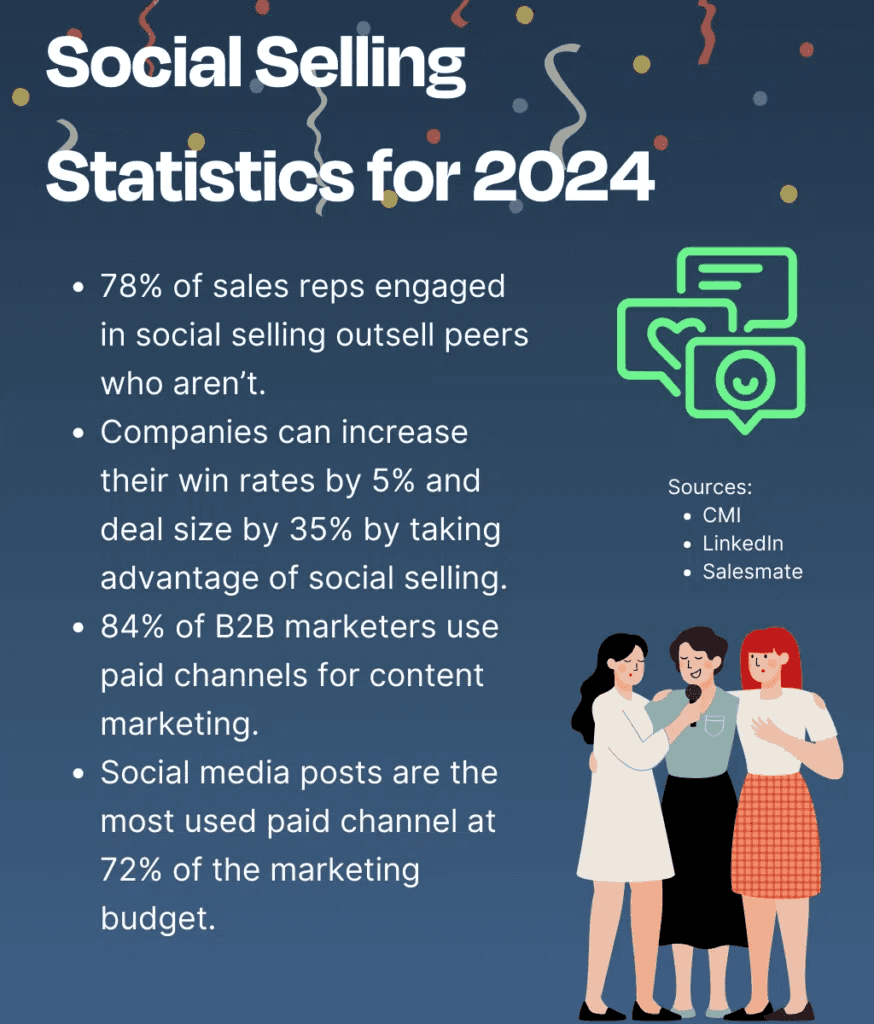
Social selling is one of the best ways to find leads. Learn more about how you can leverage social selling to its fullest potential.
78% of sales reps engaged in social selling outsell peers who aren’t. (LinkedIn)
Social selling leaders are 51% more likely to reach quota. (LinkedIn)
65% of salespeople using social selling fill their pipeline, compared to 47% of reps who do not. (Salesmate)
Social selling can increase win rates by 5% and deal size by 35%. (Lead Forensics)
Social sellers are 66% more likely to reach their quota than those using traditional prospecting techniques. (Sales for Life)
Companies can increase their win rates by 5% and deal size by 35% by taking advantage of social selling. (LinkedIn)
Maturity in lead generation converts B2B marketing revenue by 133%. (Involve)
The top type of content B2B marketers use is social media content at 95% usage. (Content Marketing Institute)
84% of B2B marketers use paid channels for content marketing. (Content Marketing Institute)
Social media posts are the most used paid channel at 72% of the marketing budget. (Content Marketing Institute)
Key Takeaway: Social selling is a highly effective strategy in the B2B space. Utilizing social media for selling can lead to an increase in reaching sales quotas. You should consider investing in social selling strategies to boost your sales and lead generation.
Sales Calling Statistics
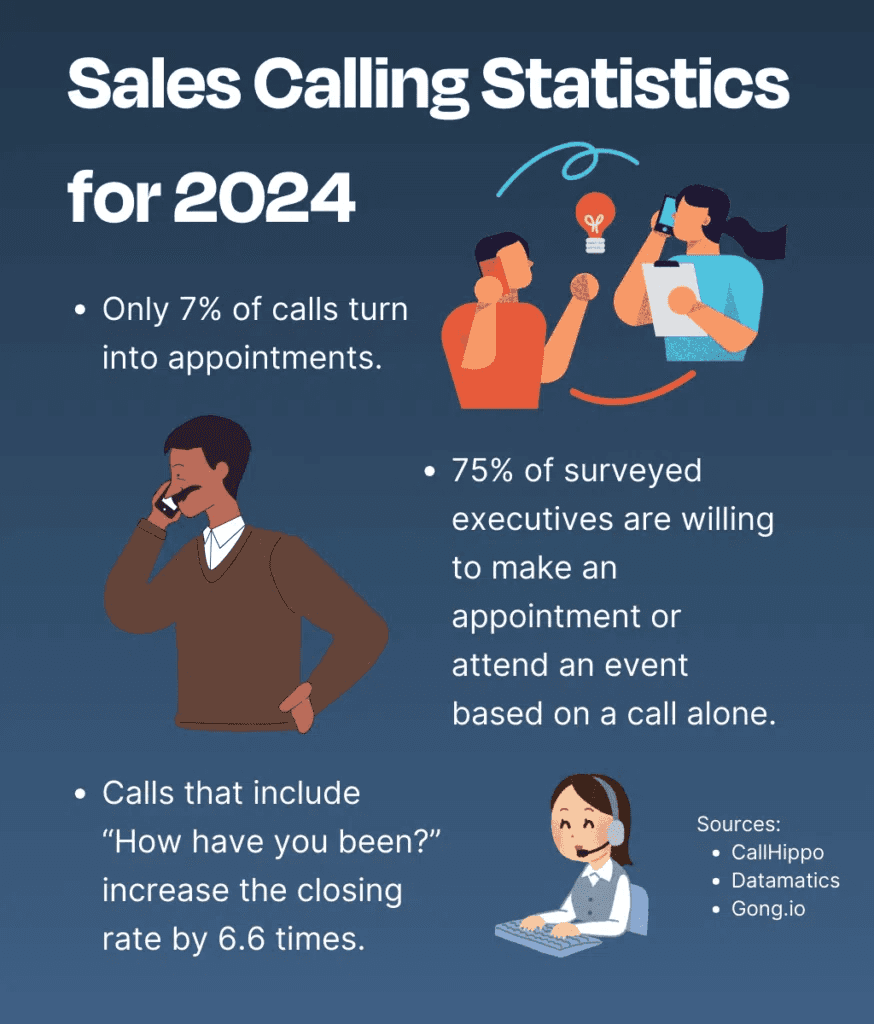
Sales calling is the process that involves sales reps contacting key decision-makers within target companies. This is a critical component in the sales process so find out more about recent data regarding it.
Only 7% of calls turn into actual appointments. (CallHippo)
The best day to call your prospects is Wednesday. (CallHippo)
The best time to call prospects or customers is between 4:00-5:00 PM. (CallHippo)
You must make at least 6 attempts to call your prospects. (CallHippo)
75% of surveyed executives are willing to make an appointment or attend an event based on a cold call or email alone. (Datamatics)
On average, it takes 18 or more dials to reach a tech prospect with cold calling. (LinkedIn)
76% of sales reps state access to remote video technology has significantly increased the number of weekly sales calls they have. (DemandScience)
Top performers have calls that last an average of 33.6 minutes. (Sales Insights Lab)
Top performers ask an average of 32 questions to their prospects. (Sales Insights Lab)
Calls that include “How have you been?” increase the closing rate by 6.6 times. (Gong.io)
Key Takeaway: Successful B2B sales calls require persistence and effective communication. You need multiple call attempts to score appointments. Moreover, you can also incorporate video technologies to land more calls.
Sales Email Statistics
B2B sales emails are straightforward messages to prospects. They usually provide some value proposition like a free trial, demo, or solution. Here are some statistics that you need to know about the topic:
44% of subscribers to mailing lists disregard direct mail entirely by not opening it. (CallHippo)
53% of marketers say email has been the most effective channel for early-stage generation. (Forrester)
On average, emails have a click-through rate of 34%, an open rate of 32%, and a conversion rate of 32%. (Demand Gen Report)
66% of buyers prefer to be contacted via email. (LinkedIn)
Email sequences with multiple attempts and multiple contacts increase response rates by 160%. (Backlinko)
The top content performance metric that 90% of B2B marketers track is email engagement. (Content Marketing Institute)
45% of respondents state that they’ll open an email because of who it’s from. (SuperOffice)
The best time to send an email is between 12 to 6 pm. (Revenue.io)
70% of salespeople give up if they don’t receive a reply to their first email. (Yesware)
91.24% of sent emails are opened on the same day. (Yesware)
Key Takeaway: Email is the best way to reach out to prospects and clients. Sales professionals should focus on crafting engaging emails and utilizing email sequences to increase response rates.
Cold Email Statistics
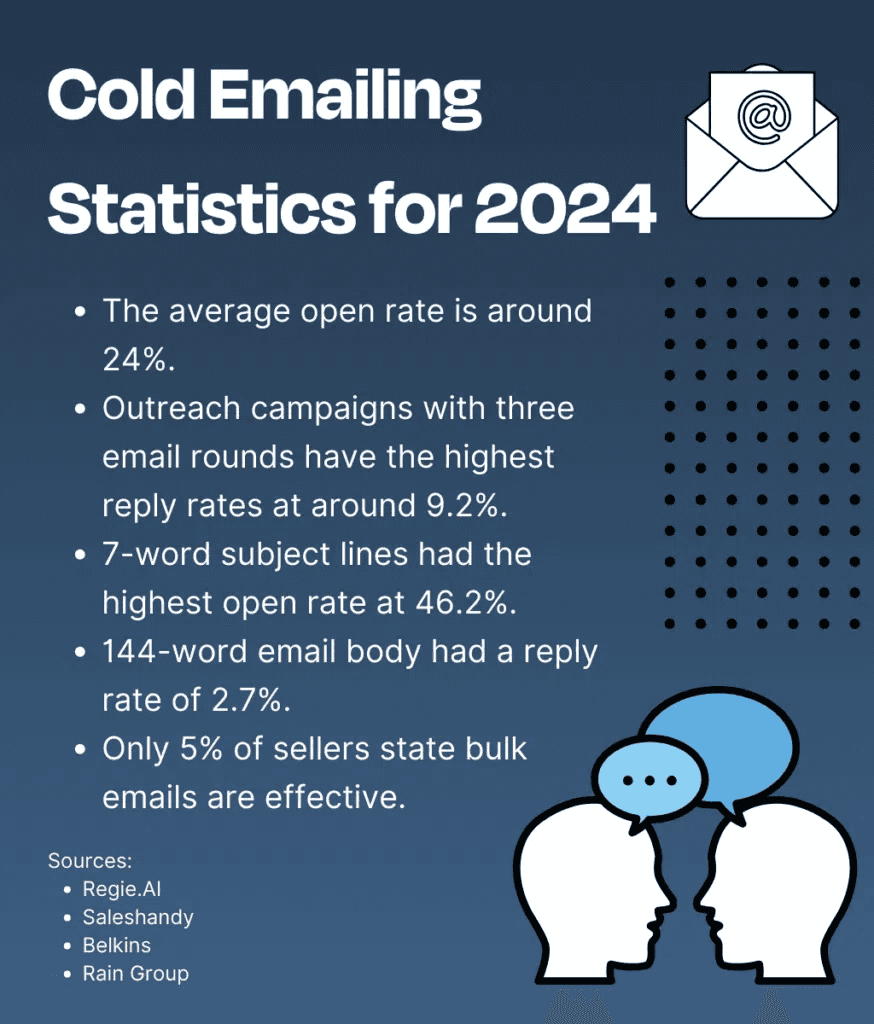
Cold emails are the other half of the bread and butter of cold outreach. Learn about the different B2B cold email statistics below:
The average open rate for cold emails is around 24%. (Saleshandy)
Cold email can generate an ROI of up to 4,400% more than any other channel. (Saleshandy)
Cold emails with 50-125 words tend to have the highest response rates. (Saleshandy)
Cold email outreach campaigns with three email rounds tend to have the highest reply rates at around 9.2%. (Belkins)
The optimal time to wait before following up on a cold email is between 2 and 5 days. (Belkins)
7-word subject lines had the highest open rate at around 46.2%. (Regie)
144-word email body had a reply rate of 2.7%. (Regie)
80% of buyers state they prefer to be contacted over email. (RAIN Group)
Only 5% of sellers state bulk emails are effective. (RAIN Group)
Only 8.5% of cold emails receive a response. (Backlinko)
Key Takeaway: Highly personalized and targeted cold emails should be the norm when sending messages to B2B prospects.
Sending bulk and generic emails is not going to cut it, but will actually turn against you, as the receiver gets a bad first impression of your brand.
Sales CRM Statistics
Customer relationship management (CRM) tools help keep sales teams organized. These tools store customer information, track data, and provide insights into customer behavior and preferences.
Half of the sellers use CRM tools, 45% use sales intelligence, and 42% use sales planning tools. (LinkedIn)
Top performers spend about 18% more time updating their CRM system than average performers do. (LinkedIn)
Only 37% of sales professionals strongly agree that their organization fully utilizes their CRM. (Salesforce)
More B2B companies are now leveraging intent data to enhance CRM and database scoring by increasing use by 17%. (DemandScience)
The CRM industry has an expected compound annual growth rate (CAGR) of 13.7%. (Grand View Research)
Key Takeaway: CRM tools are the backbone for maintaining meaningful relationships with clients. However, sales professionals have stated that they aren’t using these tools to their full potential. These tools will be continuously used with good growth rates within their markets.
Sales Engagement Software Statistics
There are a variety of sales engagement platforms that you can implement for your sales team. These tools aim to streamline and automate aspects of the sales workflow. Find out various data
85% of B2B marketers are incorporating email marketing software. (Content Marketing Insitute)
The top 2 technologies B2B organizations use to assist with content marketing are analytics tools (86%) and email marketing software (85%). (Content Marketing Institute)
69% of sales leaders are planning to invest in prospecting technology. (Prezentor)
87% of sales development organizations have adopted a sales engagement platform. (Gartner)
The global sales engagement software market has a CAGR of 14%. (FactMR)
The global sales engagement software market has a valuation of USD 9.6 million. (FactMR)
Key Takeaway: Many companies are planning to invest in more sales engagement software to improve their sales flow. This type of software is important for sales development because it provides you with a proper work setup.
AI Sales Statistics
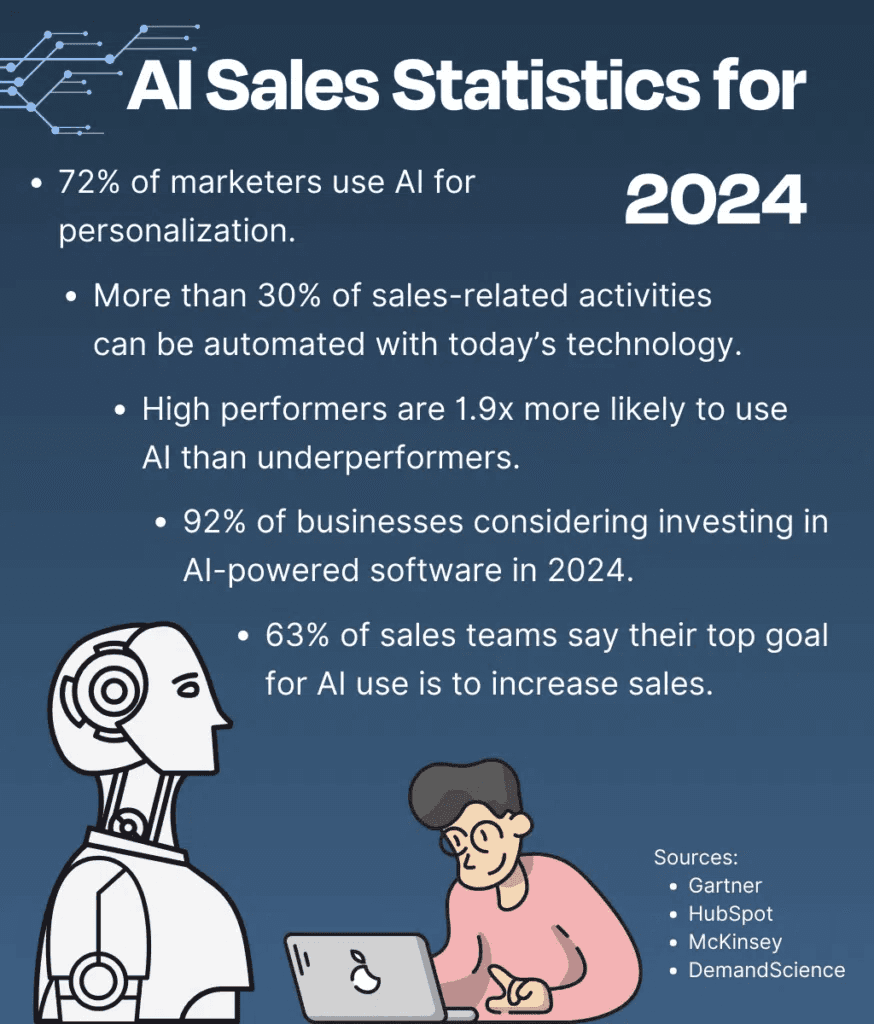
Artificial intelligence (AI) tools have drastically shifted the methods of selling for B2B sales professionals. According to recent statistics, sales and marketing leaders are leveraging AI to streamline tasks, gain valuable insights, and drive sales growth. Check them out below:
84% of respondents stated that their AI systems provided advice on the next best actions to take with prospects. (Gartner)
72% of marketers use AI for personalization. (HubSpot)
81% of sales leaders say that AI can help them spend less time on manual tasks. (HubSpot)
63% of sales leaders say AI makes it easier for them to compete with other businesses in their industry. (HubSpot)
More than 30% of sales-related activities can be automated with today’s technology. (McKinsey)
Chatbots can increase sales reps’ selling time by 15 to 20% while increasing deal-flow transparency and conversion. (McKinsey)
High performers are 1.9x more likely to use AI than underperformers. (Salesforce)
92% of businesses considering investing in AI-powered software in 2024. (Gartner)
80% of marketing organizations report having a B2B marketing automation platform deployed, leading to better marketing metrics calculation and analysis. (Gartner)
63% of sales teams say their top goal for AI use is to increase sales. (DemandScience)
By 2026, businesses that operationalize AI transparency will see their AI models achieve a 50% improvement in terms of adoption, business goals, and user acceptance. (Gartner)
Key Takeaway: Businesses are investing in AI-powered technologies to automate tasks and increase sales. This is to improve efficiency, personalization, and competitiveness. Moreover, top-performing sales reps are using AI tools to boost their productivity in sales and marketing efforts.
LinkedIn Sales Statistics
LinkedIn outreach is a key activity in any B2B sales rep’s daily work. It’s the biggest platform for organic reach and prospecting.
Social selling leaders create 45% more opportunities than peers with a lower Social Selling Index (SSI). (LinkedIn)
LinkedIn is the leading platform for lead generation. (LinkedIn)
60% of LinkedIn users are mostly millennials aged 25 to 34. (Statista)
Every 4 years, around 40% of LinkedIn members change their industry, seniority, and function. (LinkedIn)
82% of buyers look up sellers on LinkedIn before replying to their outreach efforts. (RAIN Group)
Key Takeaway: LinkedIn’s audience is predominantly professionals from various industries. B2B salespeople can capitalize on that by providing personalized outreach to them. You can use LinkedIn Sales Navigator to grow your network.
Lead Qualification Statistics
Lead qualification is a tricky business for sales reps. There’s no cookie-cutter determinator to figure out if a prospect is truly qualified or willing to buy your product. Check these stats out on how B2B sales reps perform their lead qualification procedures.
40% of agents give up on a lead after the first call. (CallHippo)
If the “Qualification” stage is 50% longer than average, then the deal is 120% more likely to slip. (Ebsta)
62% of respondents stated they focus on lead quality over lead quantity. (Demand Gen Report)
31% of respondents state they’ll leverage their SDR teams to extensively qualify prospects. (Demand Gen Report)
53% of the most qualified leads were generated via webinars. (Demand Gen Report)
Key Takeaway: You have to persistently follow up with your prospects to ensure that they’re interested and qualified. Furthermore, you have to collaborate with your SDR team so you can be on the same page as them.
Lead Nurturing Statistics
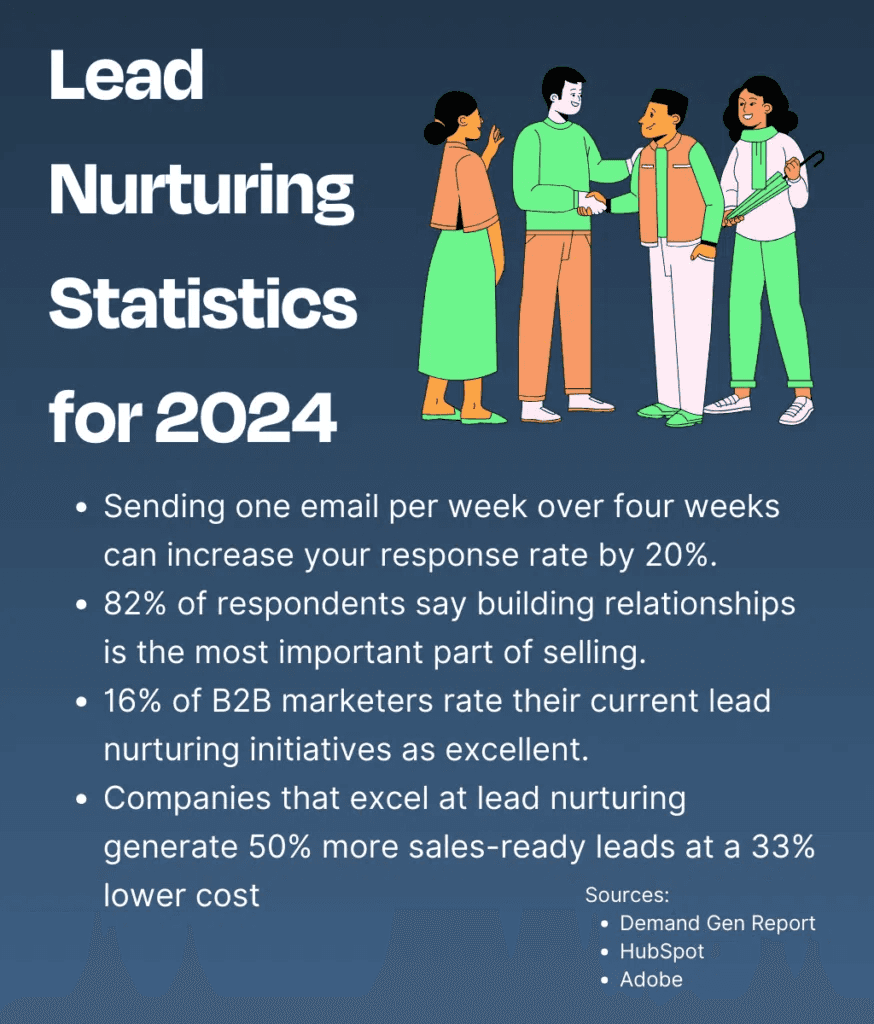
In B2B sales, nurturing leads is important for maintaining relationships. However, recent statistics reveal a gap between the ideal and the reality of lead nurturing practices. Find out more in the data below:
Only 7% of companies respond within five minutes of a prospect’s form submission. Meanwhile, 50% don’t even respond until five business days later. (Drift)
60% of customers will say no four times before they agree to a deal, but only 12 percent of sales reps are willing to keep trying after the fourth no. (Invesp)
Sending one email per week over four weeks can increase your response rate by 20%. (Saleshandy)
82% of sales professionals say building relationships with prospects is the most important part of selling. (HubSpot)
According to 50% of respondents, the best lead nurturing initiative is a sales email. (Demand Gen Report)
16% of B2B marketers rate their current lead nurturing initiatives as excellent. (Demand Gen Report)
47% of the respondents said their lead nurturing programs are average. (Demand Gen Report)
37% of B2B marketers said their lead nurturing strategies need improvement or are poor. (Demand Gen Report)
Companies that excel at lead nurturing generate 50% more sales-ready leads at a 33% lower cost. (Adobe)
Nurtured leads make 47% larger purchases than non-nurtured leads. (Adobe)
Key Takeaway: Follow-ups are important for lead nurturing because these leads potentially provide valuable opportunities. Moreover, the data highlights the effectiveness of lead nurturing efforts, with nurtured leads being more inclined to make larger purchases.
Sales Follow-Up Statistics
Effective follow-up emails are crucial touchpoints that allow your prospects more opportunities to reply to you. Learn about the different statistics that can influence how you perform follow-ups.
70% of salespeople stop at one email. (Invesp)
The first follow-up email boosts the reply rate by 49%. (Belkins)
Second follow-up emails increase the reply rate by 9%, while the third decreases the reply rate by 20%. (Belkins)
Sending at least three follow-up emails can increase the response rate by 28%. (Saleshandy)
48% of salespeople never even make a single follow-up attempt. (Invesp)
4-word follow-up emails had the highest open rates at 56.6%. (Regie)
39-word follow-up email body had a reply rate of 41.8%. (Regie)
Key Takeaway: Follow-up emails significantly impact response rates. While many sales reps stop at one, sending multiple follow-ups can increase the response rate from prospects. Keep your follow-ups concise and personalized and you should see some responses.
Sales Referral Statistics
Referrals are a great source of potential prospects. Find out more about how referrals can positively influence your B2B activities.
83% of the customers are open to referring a business after conducting a successful purchase. (ThinkImpact)
Referrals end up creating 65% of new business opportunities. (ThinkImpact)
27% of sales officers attribute up to 50% of the new clients that they get to B2B referrals. (ThinkImpact)
91% of B2B referrals influence customers by word of mouth. (ThinkImpact)
78% of the B2B referrals create viable customer leads for the business. (ThinkImpact)
3 in every 10 B2B businesses have a formalized referral business. (ThinkImpact)
87% of sales marketing efforts are effective when using B2B referral marketing while only 42% of the sales marketing efforts are effective without it. (ThinkImpact)
54% of B2B referrals have a much lower cost when compared to other sources of leads. (ThinkImpact)
B2B referrals provide 30% more leads that generate revenue for the business as compared to other marketing channels. (ThinkImpact)
57.9% of respondents say they only ask for fewer than one referral per month. (Sales Insights Lab)
Key Takeaway: Customers are open to referring a business after a successful deal. Salespeople attribute a substantial portion of their new clients to referrals. Despite the benefits, many sales reps ask for fewer than one referral per month. This indicates a potential area for improvement in leveraging the power of referrals.
Sales Closing Statistics
Sales closing is the last part of the initial negotiation process with clients. Effective sales closing is crucial for achieving sales targets and driving revenue growth in a business.
The average sales close rate is 29%. (HubSpot)
81% of sales reps say that team selling helps them close more deals. (Salesforce)
Sales teams use an average of 10 tools to close deals. (Salesforce)
Top performers are 366% more likely to close an opportunity at the ‘Discovery’ stage. (Ebsta)
It takes twice as long to close deals in B2B SaaS as it does for B2B commercial and professional services companies. (Dreamdata)
Large B2B companies take 64% longer to close deals. (Dreamdata)
On average, across B2B industries, there are 31 touches before a deal is closed. (Dreamdata)
81.2% of respondents believed that an inability to offer flexible payment options hindered deals from closing. (Capchase)
Only 2% of sales occur at the first meeting. (Marketing Donut)
Key Takeaway: According to the data, closing deals are incredibly difficult. However, team selling tactics have been proven to be effective in increasing the chances of closing deals. Moreover, buyers have voiced out wanting more flexible options to give more freedom of choice.
Sales Career Statistics
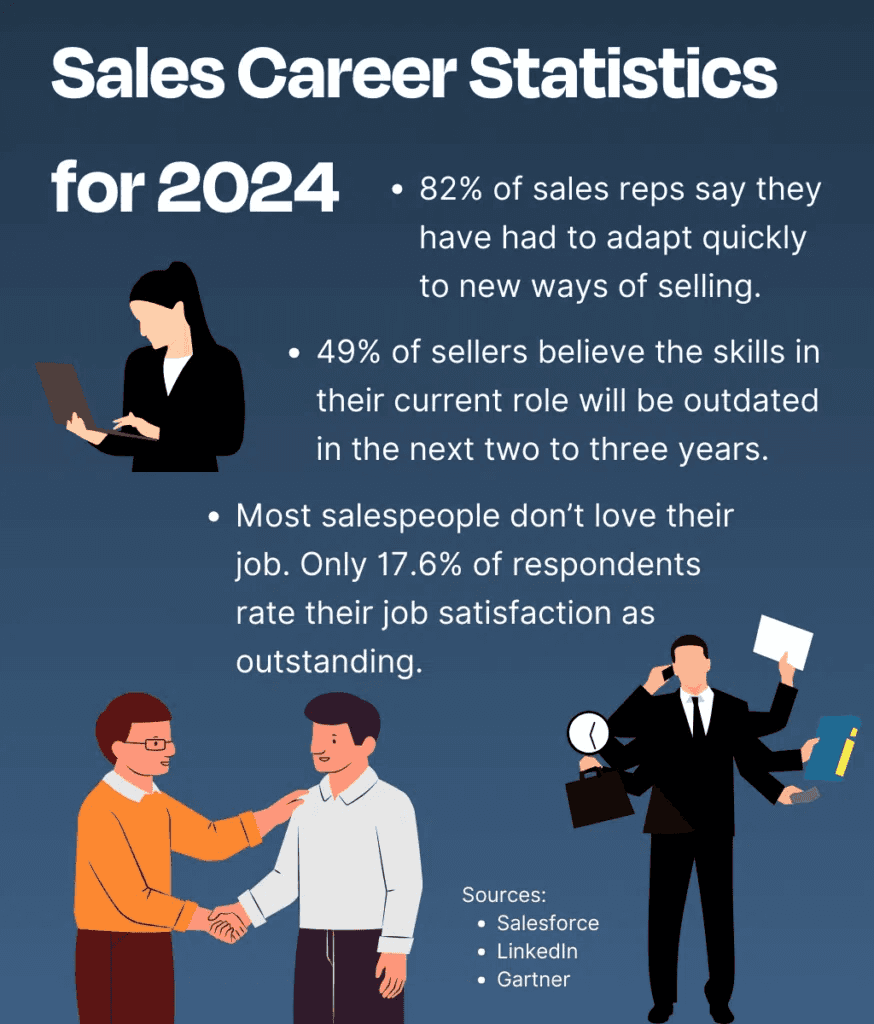
A career in B2B sales entails a lot of entrepreneurial and communication skills. Find out how you can jumpstart your sales career with these statistics below:
82% of sales reps say they have had to adapt quickly to new ways of selling. (Salesforce)
63% of sellers say cold calling is the worst part of their job. (LinkedIn)
49% of sellers believe the skills in their current role will be outdated in the next two to three years. (Gartner)
Sales managers have a median pay of $135,160 per year. (Bureau of Labor Statistics)
The median on-time earnings (OTE) for an SDR is $76,000. (The Bridge Group)
The median OTE for an SDR Manager is $128,000. (The Bridge Group)
The median OTE for an AE Manager is $156,000. (The Bridge Group)
The median OTE for a Director of Sales Development is $177,000. (The Bridge Group)
The median OTE for a Director AE is $218,000. (The Bridge Group)
Most salespeople don’t love their job. Only 17.6% of respondents rate their job satisfaction as outstanding. (Sales Insight Lab)
Key Takeaway: B2B sales is a rapidly evolving industry that requires you to be adaptable. Although many salespeople believe their skills will be outdated in a few years, this career is still a lucrative pursuit for anyone who wants to try their knack in sales.
Sales Training Statistics
Sales training is crucial for B2B companies because recent data has shown how costly it can be to onboard new hires. Some innovations show that you can quickly onboard new hires with minimal costs. Find out more below:
Only 60% of sales hires will stay with the company for at least six months. (Allego)
The average cost to onboard a new sales employee is $9,589. (Allego)
By 2026, sellers will spend 65% fewer hours in training. (Gartner)
Organizations that use just-in-time learning are 2.5x more likely to exceed seller revenue targets, 3.5x more likely to exceed customer retention targets, and 2.3x more likely to exceed retention targets. (Gartner)
40% of sales teams face long onboarding times. (Prezentor)
75% of sales professionals are confident in their sales organization’s ability to retrain reps for a new selling landscape. (Salesforce)
Only 26% of sales professionals say they receive one-on-one coaching from their managers at least weekly. (Salesforce)
On average, sales reps at winning organizations take four weeks to complete an onboarding program and are fully ramped in four to five months. (Mindtickle)
Companies spend an average of $2,020 per sales rep on training. (ATD)
Most companies will spend between $10,000 and $15,000 on hiring a single sales rep. (ATD)
Key Takeaway: B2B companies face many challenges in retaining new hires and the significant costs of hiring and training new sales employees. There’s an emphasis on using innovative learning tools like just-in-time learning. Lastly, companies should focus on comprehensive onboarding programs that ramp up new hires while minimizing costs.
Sales Productivity Statistics
Learn how to maximize your output with these sales productivity statistics. You can improve your B2B sales activities by streamlining your systems and incorporating tools.
53% of sales reps say the sales technology stack aids productivity and positively impacts results. (Forrester)
By 2027, statistical analysis, application development, data visualization, and strategic planning will be the top skills for sales operations. (Gartner)
66% of sales reps say they’re overwhelmed by too many tools. (Salesforce)
Adapting to hybrid or virtual selling is the top tactic to drive sales growth. (Salesforce)
Sales reps spend a mere 28% of their week actively selling. (Salesforce)
69% of sellers state that selling is harder now. (Salesforce)
A single outbound sales rep should average 60 calls per day. (Revenue.io)
81.6% of top performers spend 4 hours or more on sales-related activities. (Sales Insights Lab)
Only 24.3% of salespeople exceed their quota. (Sales Insight Lab)
63% of organizations have ten or more tools to support sales activities – but sellers incorporate fewer into their daily workflows. (Mindtickle)
Key Takeaway: While sales technology can enhance productivity, many sales reps feel overwhelmed by the number of tools available. Despite the potential of technology, sales reps spend only a fraction of their time actively selling.
Sales Success Statistics
Sales success refers to the achievement of sales goals. Check these statistics about sales success:
Elite performers win 73% of their sales opportunities. (RAIN Group)
Top performers win 62% of their sales opportunities. (RAIN Group)
42% of companies saw a decrease in win rates, with 30% declining by 11% or more. (Lightspeed)
91% of sales pros upsell, and they say it brings in an average of 21% of company revenue. (HubSpot)
The average sales win rate is 21%. (HubSpot)
Key Takeaway: Top performers produce the majority of a B2B company’s revenue. However, there’s room for improvement, as companies experienced a decrease in win rates.
Door-to-Door Sales Statistics
Check these latest door-to-door sales statistics:
For every 40 houses or businesses knocked, agents typically talk to approximately 40-50% of the owners (home or business), which generates about 16-20 prospects. (LeadHeroes)
20% of customers still purchase through door-to-door sales. (Gitnux)
Door-to-door sales and outside sales make up 71.2% of the current sales force. (Zendesk)
Key Takeaway: Door-to-door sales remain a significant aspect of the sales force, with agents typically engaging with owners when knocking on doors. Despite the growth of digital sales channels, customers still make purchases through door-to-door sales.
Sales Statistics by Region
North America Sales Statistics
The North American B2B e-commerce market is expected to register a CAGR of 10.2% for the forecast period 2022-2027. (Mordor Intelligence)
35% of sellers use sales engagement tools. (LinkedIn)
43% of sales organizations consider buying intent very important. (LinkedIn)
70% of the highest-performing sellers work closely with marketing. (LinkedIn)
52% of buyers research sellers who reach out to them by Googling them. (LinkedIn)
37% of B2B marketing budgets will be allotted to lead generation. (LinkedIn)
48% of CMOs state that finding and acquiring new customers is considered a top challenge. (LinkedIn)
66% of B2B marketers state that creative strategy and execution are the most important skills to have. (LinkedIn)
59% of B2B marketing leaders state that in-person events are the top marketing technique they plan to use. (LinkedIn)
United States of America (USA)
By 2024, B2B advertising spending will reach $18.5 billion. (Statista)
Advertising of B2B tech products accounted for over 32% of B2B advertising expenses. (Statista)
40.6% of respondents said one-to-one outreach was the main factor behind successful qualified lead generation for their B2B business. (Statista)
40% of respondents said that a lack of internal expertise was their main challenge in executing an account-based marketing strategy. (Statista)
Merchant wholesalers had sales of $11,382.3 billion. (US Census Bureau)
Canada
25% of B2B payments are conducted by debit or credit cards. (Mordor Intelligence)
42% of B2B revenue comes from digital channels. (Statista)
Over 52% of B2B organizations invest in employing sales representatives. (Statista)
South America Sales Statistics
39% of B2B marketing budgets will be allotted to brand building and awareness. (LinkedIn)
54% of CMOs state that incorporating emerging technology is considered a top challenge. (LinkedIn)
78% of B2B marketers state that marketing technology and data analytics mastery are the most important skills to have. (LinkedIn)
66% of B2B marketing leaders state that in-person events are the top marketing technique they plan to use. (LinkedIn)
Brazil
82% of sellers say they research before contacting a potential client. (LinkedIn)
70% of buyers prefer sellers to reach them via email. (LinkedIn)
52% of top sellers’ performance indicated that they have increased significantly their efforts to expand their network on LinkedIn. (LinkedIn)
63% of salespeople with better performance stated that the sales started working very closely with marketing in brand campaigns. (LinkedIn)
56% of sellers say they closed deals over US$100,000 without ever meeting buyers personally. (LinkedIn)
68% of top sellers always prioritize customers. (LinkedIn)
Mexico
76% of top sellers said they’re committed to publishing more articles on LinkedIn. (LinkedIn)
73% of buyers stated they’re unlikely to engage with sellers who don’t present a good image online. (LinkedIn)
92% of salespeople said that determining buying intent is important to their sales organization. (LinkedIn)
78% of top sellers said that they always prioritize clients. (LinkedIn)
76% of top salespeople said their sales department started working very close to marketing in the selection of segments. (LinkedIn)
The best salespeople identified the ability to close more deals and generate 46% more revenue as the main advantage of using sales technology. (LinkedIn)
62% of sellers say they closed deals above US$100,000 without ever having met with buyers in person. (LinkedIn)
Europe Sales Statistics
38% of B2B marketing budgets will be allotted to lead generation. (LinkedIn)
41% of CMOs state that finding and acquiring new customers is considered a top challenge. (LinkedIn)
68% of B2B marketers state that creative strategy and execution are the most important skills to have. (LinkedIn)
54% of B2B marketing leaders state that video is the top marketing technique they plan to use. (LinkedIn)
United Kingdom
93% of B2B buyers now choose e-commerce platforms such as marketplaces, apps, and websites for their procurement needs. (B2BEA)
83% said they would abandon an eCommerce purchase if no payment terms were offered at checkout. (B2BEA)
74% of salespeople say that more customers have changed companies in the past year than previously. (LinkedIn)
Over 52% of buyers say they’ve purchased from a sales rep they were a client of at a previous company. (LinkedIn)
A salesperson who exceeds 50% of their quota spends only 24% of their time selling. (LinkedIn)
Salespeople who exceed quota are significantly more likely to say that they always research prospects before reaching out. Among those who exceed 50% of their quota, 69% always research. (LinkedIn)
Salespeople who beat 50% of their quota or more are more than twice as likely to rate the quality of their marketing leads as “excellent.” (LinkedIn)
Nordic Region
63% of top salespeople say they always do research before approaching prospects. (LinkedIn)
43% of buyers value after-sales and 28% consider it very important. (LinkedIn)
Only 14% of buyers still appreciate being cold-called. (LinkedIn)
Sellers spend 25% of their time in actual selling. (LinkedIn)
37% of buyers research to validate whether a seller is telling the truth. (LinkedIn)
By 2025, B2B e-commerce revenue of physical goods is forecast to hit nearly 35 billion U.S. dollars. (Statista)
6 in 10 organizations have plans to launch digital commerce channels in the coming years. (Statista)
Around 35 percent of B2B companies’ revenue came from digital channels. (Statista)
Integrating personal sales with online platforms is seen as the biggest challenge in B2B digital sales. (Statista)
Asia Sales Statistics
Central Asia
The gross merchandise value (GMV) of B2B e-commerce in the manufacturing sector in India amounted to nine billion U.S. dollars. (Statista)
In the next few years, China’s B2B e-commerce market is predicted to grow rapidly, with its market size approaching ¥19.5 trillion. (Statista)
The data expects the market to reach US$ 147.4 Billion by 2032, exhibiting a growth rate (CAGR) of 32.2% during 2024-2032. (IMARC Group)
Southeast Asia (APAC)
32% of B2B marketing budgets will be allotted to lead generation. (LinkedIn)
54% of CMOs state that finding and acquiring new customers is considered a top challenge. (LinkedIn)
62% of B2B marketers state that problem-solving is the most important skill to have. (LinkedIn)
61% of B2B marketing leaders state that thought leadership is the top marketing technique they plan to use. (LinkedIn)
90% of sellers who reached 150% of quota or more use sales tech at least once a week. (LinkedIn)
CRM is considered important or very important by 100% of sellers. (LinkedIn
Australia and New Zealand Sales Statistics
Every 4 in 10 B2B organizations had already implemented AI technologies in their e-commerce operations. (Statista)
The manufacturing sector is the biggest B2B industry with over 28,000 registered businesses. (US Marketing Management)
69% of B2B buyers prefer to shop at a brand’s website. (B2BEA)
69% of B2B buyers discover new products via search engines. (B2BEA)
76% of B2B sellers use social media to promote their products. (B2BEA)
Middle East and Africa (MEA) Sales Statistics
The MEA B2B payments market value could reach 122 billion U.S. dollars by 2030. (Statista)
The MEA B2B e-commerce market is projected to reach USD 2,293 billion by 2030, registering a CAGR of 19% during the forecast period (2022-2030). (Straits Research)
The number of B2B digital buyers is likely to surge roughly to 520 million by 2025. (Market Research)
Sources
LinkedIn
Market Research
Statista
Markletic
HubSpot
Gartner
Forrester
Straits Research
IMARC Group
The Bridge Group
Gong
Ebsta
Demand Gen Report
Mordor Intelligence
Zendesk
Salesmate
US Census Bureau


